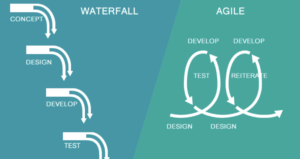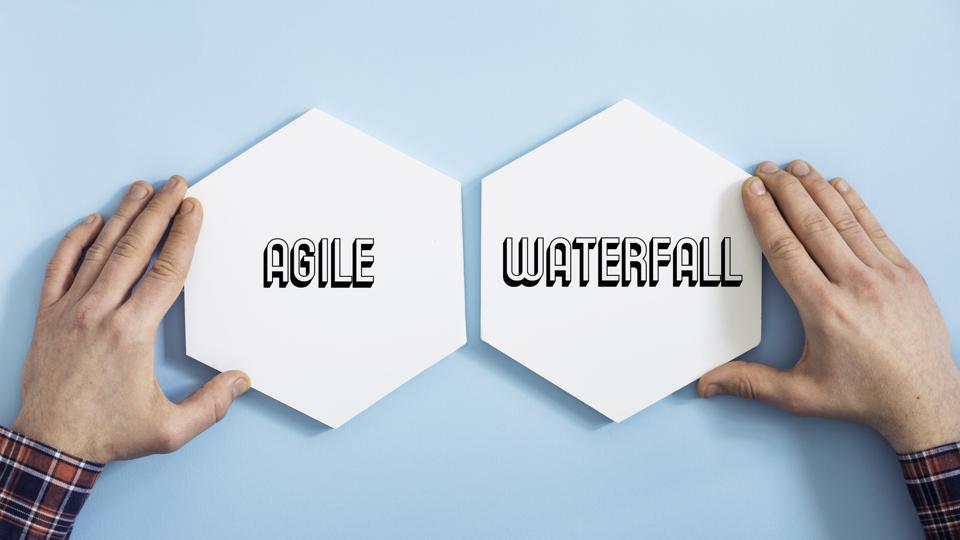One of the first decisions you face as a project manager is which project management methodology you should use to get the best results—in the shortest time possible and within budget.
Waterfall and Agile are among the most common PM options, and for good reasons.
Waterfall is a linear process that requires the team to complete each project phase before moving on to the next one. Agile, on the other hand, enables the team to work simultaneously on different phases of the project and make iterations as they go.
But still, which of these two approaches is best for your project?
To help you decide, in this guide, we discuss the following:
What Waterfall project management is
What Agile project management is
The pros and cons of Agile project management
The pros and cons of Waterfall project management
How to choose between Agile and Waterfall approaches
What Is Waterfall Project Management?
Waterfall is a linear project management approach that focuses on upfront planning. The requirements are fully defined before a project commences and divided into multiple phases.
As its name suggests, project phases in a waterfall methodology cascade downward (similar to a waterfall) and are organized in sequential order. You must complete one phase before you move to the next.
This project methodology is best suited for projects that involve predictable, recurring processes.
What Is the Agile Project Management Approach?
Agile project management is an iterative approach that involves making incremental steps as the work progresses instead of completing all the work at once.
The Agile process is best suited for projects whose significant constraints aren’t well understood. For instance, when developing a new product, you may be unable to determine the project’s scope and timeline in advance. This is where Agile can come in handy.
The Agile method allows you to work on the product systematically, in stages, while incorporating customer feedback as you go. This way, you can adjust and iterate during the development process.
One of the key aspects of Agile is its set of principles and values. They were created in 2001 and listed in the Agile Manifesto of Software Development:
- Individuals and interactions over processes and tools
- Working software over comprehensive documentation
- Customer collaboration over contract negotiation
- Responding to change over following a plan
Pros and Cons of Agile Project Management
If you’ve been in the project management world for any amount of time, you know that there are various project management methodologies. Each approach has its pros and cons, and Agile is no different.
The Agile methodology is, without a doubt, one of the most popular project management techniques. Hardly surprising when you see the many ways it can benefit project teams who choose to go Agile.
- Flexibility: The approach’s flexibility allows team members and stakeholders to test requirements at every phase of the project. With such flexibility, you can make adjustments and changes immediately, increasing the chances of delivering a project that meets expectations.
- Prioritization: Agile methodology teaches you how to prioritize! It emphasizes taking care of tasks that matter most to deliver value.
- Quick problem detection: Agile teams test product increments as they produce them, so it’s easy for them to notice and solve problems when they crop up.
- Faster delivery: When using the agile process, teams carry out each small project increment faster in a series of repetitive cycles. The increments don’t need to be perfect since the goal is to build upon these foundations on an ongoing basis.
- Easier collaboration: The Agile approach is a very collaborative and iterative approach. The client and project development will work hand-in-hand, with regular feedback along the way. This encourages teamwork, collaboration, and accountability to produce a better product with each round of feedback teams receive.
- Transparency: In Agile, everything from ideation to testing and launch is a transparent process. With such open visibility, everyone involved stays on the same page and works towards the same goal.
Of course, we would be remiss not to point out some of the disadvantages of implementing Agile as well.
It’s difficult to define the critical path and inter-project dependencies when using the Agile approach.
Agile is highly flexible, which could sometimes lead to scope creep. Some stakeholders may demand more improvements and iteration at each stage.
The ad-hoc, reactive nature of the Agile method can make it hard for project managers to determine project specifics like deadlines and costs. This can lead to sloppy project budgeting and poor timing—especially if projects tend to go through constant iterations.

Pros and Cons of Waterfall Project Management
Moving on, let’s take a look at the pros and cons of the Waterfall approach as well. It’s excellent for simplifying project planning, tracking task dependencies, and maintaining structure and balance within a project. But it has its drawbacks too.
First, here’s what the Waterfall methodology does best.
- Requires less coordination because you have clearly defined phases with sequential processes
- It involves clearly defined work dependencies.
- Once you’ve defined your requirements, you can quickly and efficiently estimate the cost of the project.
- Project planning is easier in Waterfall because stakeholders agree on what will be delivered upfront.
- Waterfall allows for flexible resource planning and allocation. Team members only need to be available during their specific project phases. This means they can continue focusing on other areas or projects when not working on your project.
- Technical project documentation is a necessary part of the initial requirements phase. This makes it easy for everyone to understand the project objectives.
- Since teams must review each phase before moving on to the next, stakeholders have much higher visibility into the project’s progress.
Waterfall teams may face unexpected shortcomings, including:
- Waterfall has stricter phase sequences making it harder to break up and share work.
- Time wastage due to delays and setbacks during phase transitions.
- You must have comprehensive requirements up front in a Waterfall project. This can sometimes be challenging for very complex or longer-term projects.
- Waterfall’s sequential nature can cause rigidity in the project, making it challenging to make mid-project pivots or directional shifts.
How to Choose Between Agile and Waterfall Approaches
Now that you understand how each approach works and its pros and cons—how do you decide which one to use?
Well, it depends. Just the vague answer you were looking for right? But hear us out!
The methodology you choose will really depend on the nature of the project you want to manage and the organization you work for. You also need to really analyze the pros and cons of each methodology (as discussed above) to pick the right option for you.
Still confused?
When to use the Agile approach
- It makes the most sense to use Agile for projects:
- Based on incremental progress,
- That have complex deliverables, or
- Consist of multiple non-successive timelines.
If your project requires a cohesive and collaborative but cross-functional team to deliver, then it’s best to use Agile over the Waterfall methodology.
The Agile approach is also best for projects where processes or roles are unclear, as it leaves room for figuring it out as you go along.
Agile is the best approach when dealing with products that customers already own and require incremental improvement.
When to use the Waterfall approach
The Waterfall approach is most suitable for less complex projects or projects with well-defined requirements, processes, and roles for team members.
These projects will usually have a single delivery timeframe, and project details and expectations are defined at the beginning of the project. Further, these expectations will likely stay the same along the way, making Waterfall the ideal way to manage such projects.
If you’re facing budget and/or time restrictions but clearly understand the project requirements and scope, the Waterfall methodology will be your best option. The Waterfall process is strictly organized, and each project phase comes out more fully formed, making it simpler to budget the money, time, and labor that go into completing the project.
Use Project Management Software That Can Do Both Waterfall and Agile
You don’t always have to choose one or the other. Sometimes, a hybrid Agile Waterfall approach may make the most sense. It helps to have a project management tool that is flexible and can incorporate whichever method you choose to help meet your goals.
Enter Mission Control—a powerful project management tool that allows you to run your projects using either Agile or Waterfall, or a happy hybrid of both.
You can set up a Waterfall workflow using our in-built Gantt charts or create custom workflows on a Kanban board to set up your Agile process.
Whether you choose Waterfall or Agile, you’ll be able to closely monitor project progress within our project management software. We also offer an in-built communication tool that makes it easier to maintain communications with team members and stakeholders. The tool also makes it easy to share important information and documents throughout the course of the project.
Plus, we’re not just limited to Agile and Waterfall. The tool can be customized to almost any project management method you choose to incorporate.
Request a demo to see how Mission Control can help you manage your project using Agile or Waterfall approaches.




